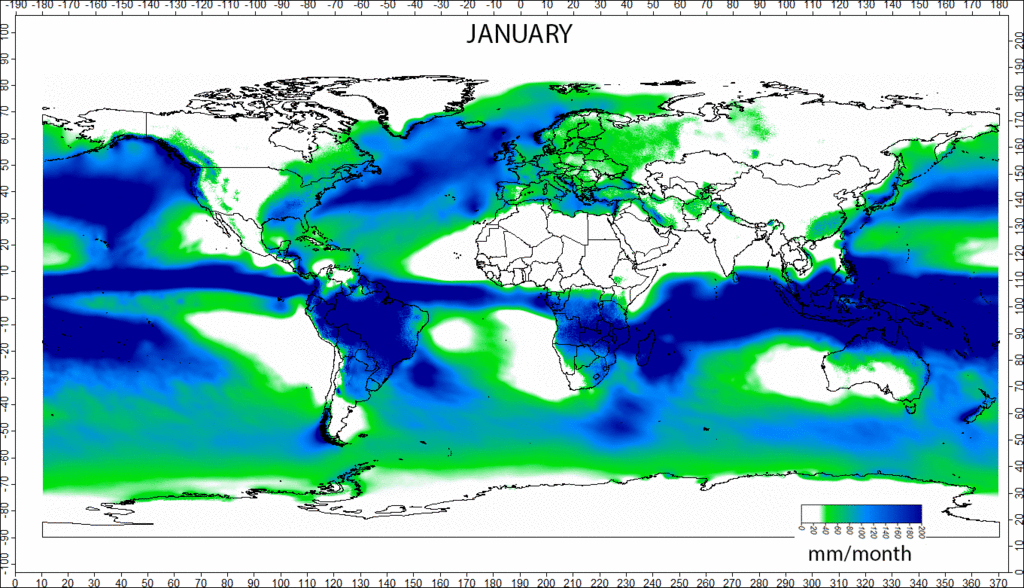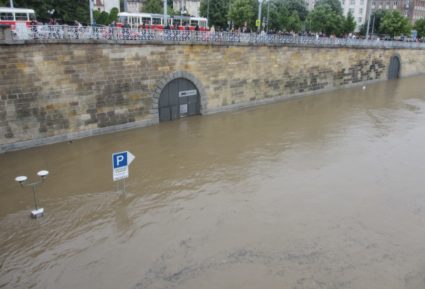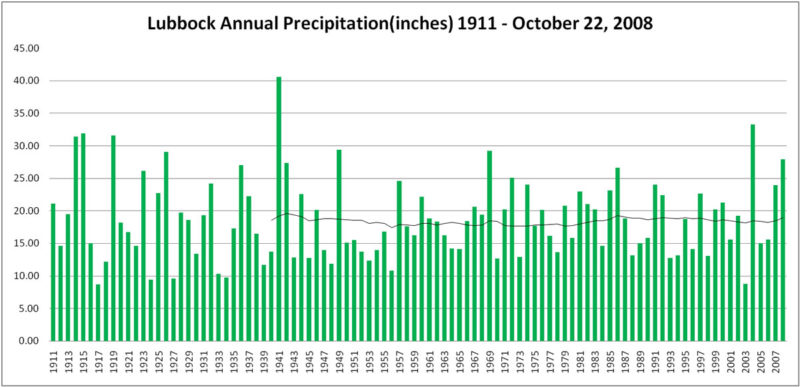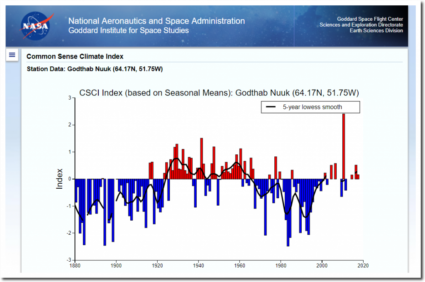Two weeks ago, I discussed the unusually thick layers of pollen on cars due to the relative shortage of precipitation in my homeland.
Yesterday, most of Czechia saw intense rain and in Moravia, today is predicted to cover about 50% of the average precipitation for the whole month of May. (The figure 50% is changing rather wildly.) It’s been modestly raining for a week and at least an additional four days are predicted.

In Czechia, January 2018 had precipitation near the average, the following three months were visibly below the normal. Let’s discuss Pilsen. It has 600 mm of precipitation per year i.e. 50 mm per month – all seasons are comparable although the harsh winter may reduce the precipitation rates.
During the first four months of 2018, we were expected over 150 mm of rain, but we only got over 100 mm, i.e., 30% less. Is that extreme?
Well, it’s not really too extreme. Let’s look at a random graph of annual precipitation that I could find, that from Lubbock, Texas:
The graph says that they get some 18 inches (460 mm) per year on average. Even when it comes to the annual figure, the drop by 33% – to 12 inches – was common, especially in the early-20th century.
If you take a shorter period, like four months, a drop of 33% is even more ordinary due to the higher statistical fluctuations. Shorter periods mean a less accurate “averaging out” of the flukes.
So it’s not really unusual to get 30% less-than-average precipitation over a 4-month-long period. Unlike the temperature graphs, the precipitation graphs have no reason to be continuous.
While the temperature graphs may resemble red noise or pink noise and the continuity follows from the energy flows that are required to change the temperature at all, the precipitation charts such as this one are naturally close to the white noise: every new year (or month) starts from scratch and has no good reason to repeat the positive or negative swings from the average during the previous period.
On top of that, there is this difference between the average and the median. In Czechia – and it’s similar elsewhere – 2/3 of the people have a below-the-average salary. How is it possible? Well, by definition of the median, exactly 1/2 have a below-the-median salary.
But the arithmetic average is higher than the median because a relatively small number of people have really high salaries which increase the average but not the median.
On the low side, the salaries are bounded by zero (well, a positive number comparable to 1/3 of the average salary) so the distribution is asymmetric.
That’s what makes it more likely than 50% that the precipitation in a month is below the average, too. Three months like that in a row aren’t unusual at all.
But even after that intense rain on Tuesday and especially Wednesday, the media are still full of hysteria about the “extreme” drought.
And what annoys me is that the readers who buy this garbage seem to be in a majority. Can’t they see that it’s just garbage?
What’s most spectacularly clear to everybody who actually looks around is that everything is green, all plants are blossoming, all trees that should already bear fruits are full of fruits. The birds are singing like mad. Haven’t all these people seen the actual nature? Don’t they enjoy it? I do.
Ivan Mládek, A Sourball’s (Global Warming Alarmist’s) Spring Song. Lyrics: A sourball with a flute is playing a song about the spring, and then, as is commonplace in music, after his flute solo, he also sings: The damn spring has arrived again, birds yell and the lilacs stink. Because of all those chickens, there’s no place to spit, in the warm weather, my dried honey has soured. The Sun is annoyingly creeping into the villa, my snowman is already collapsing. Ices are cracking and the balks are drying up, Annie is painfully twisting her body. Because of an Easter whip, kids are ruining a willow. Goslings are sizzling like snakes at the doorstep. The damn spring is already here again, I prefer not to approach the window. Again, the buds, blossoms, and grass, I will once get mad in the spring.
So I am annoyed how easily the people – even in the relatively skeptical Czechia – get brainwashed by the totally deceitful, catastrophic talk about drought and similar phenomena.
They should be sent to 1947 to recall what an actual dry year looks like (for 40 years, we had to be grateful for the Soviet corn; I would have preferred to have been grateful for some donated Western corn).
It’s almost certain that May 2018 will already be above average when it comes to precipitation in Czechia. There’s absolutely no reason for any panic and no reason to expect a bad harvest or anything like that.
There’s a silver lining in this particular hysteria about the drought: it’s not claimed to be global, and it’s not claimed to be due to CO2.
Thank God, people may see that Southern Europe is seeing above-the-average precipitation in recent weeks.
Also, last Sunday (4 days ago), we enjoyed a Pilsen that was significantly warmer than the French Riviera, too. 😉 On top of that, mankind is sometimes blamed for the drought but it’s mostly the sewer systems, roads, concrete, and big fields that are to blame.
Well, I grew highly skeptical about these claims as well but at least people aren’t ludicrously choosing CO2 as the culprit of their would-be catastrophes.
Right now, there is simply no “catastrophe” – and even no reason to worry – when it comes to threats like “damaging droughts”.
Everyone who looks what the wildlife is doing must know that. On the other hand, lots of mayors may want to get some extra subsidies and that’s why they’re whining about the terrible droughts. People should be sane and they shouldn’t get manipulated by these claims.
And I hope that the relatively unchallenged Sun will return – the morning swimming on Monday and Tuesday was great and I am already missing it.
Read more at The Reference Frame



















We had two big Thunderstorms in my area in Northern California with heavy rain and the puddles left behind were full of pollen